Best Canon RF lenses 2022: the best lenses for Canon's mirrorless EOS R cameras
The finest glass for your Canon EOS R-series camera
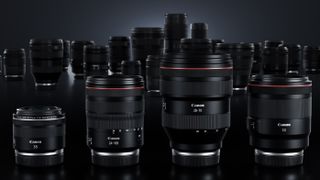
Looking for the best Canon RF lenses for your new EOS R camera? You've come to the right place.
In three years since the launch of Canon's full-frame mirrorless system in October 2018, the camera maker has added a total of 15 RF lenses to its catalogue. This includes the newest pair to join the growing stable of great glass – the RF Canon RF 100-400mm f/5.6-8 IS USM zoom and the wide-angle RF RF 16mm f/2.8 STM. Both are relatively affordable, unlike a lot of the best RF lenses, meaning Canon is catering to all kinds of photographers with different budgets.
The best part about the EOS R system is that you aren't restricted to using RF lenses. The entire range of EF lenses that were designed for the Canon full-frame DSLRs is compatible with mirrorless bodies via a lens adapter. And more often than not, they'll likely be available for cheaper as well.
However, there are advantages to using the native RF lenses – after all they were specifically optimized for the EOS R cameras. They're innovative and bring performance enhancements over their EF counterparts to match each class of lens.
Pair an RF lens with an EOS R body and they're a match made in heaven – it's just the right tool for the job. For one thing, with no reflex mirror assembly to get in the way, the rear of the lens can be closer to the image sensor. This enables greater design freedom and enhanced optical performance.
Another factor is that, compared with DSLRs and EF mount lenses, there’s a huge data speed increase between EOS R-series cameras and the best RF lenses, which helps with the likes of image stabilization and ‘intelligent’ autofocus. Canon’s Japanese design engineers describe the speed increase as being like the difference between a moped and a bullet train.
There are precious few independently created lenses for the EOS R system as yet, and most notably none from Sigma or Tamron (in January 2021, Sigma's CEO did confirm new RF lenses will be coming in the future). However, Canon has rolled out a great range of high-performance lenses at varying price points, to suit everyone from keen amateurs to hardcore professional photographers.
To make it easier for you, we've rounded up of the best RF lenses in the most popular categories in this in-depth guide, from wide-angle to super-telephoto lenses.
Best Canon RF lenses in 2022:
Why you can trust TechRadar

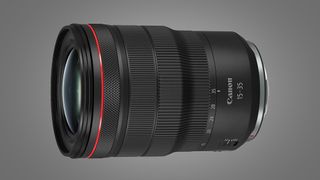
Wide-angle zoom: Canon RF 15-35mm f/2.8L IS USM
Specifications
Reasons to buy
Reasons to avoid
Many enthusiast and professional photographers favor ‘trinity’ zoom lenses, the three staples being wide-angle, standard and telephoto lenses that each have a fast and constant aperture rating of f/2.8. This pro-grade lens fits the wide-angle bill, with typically high-end, weather-sealed L-series build quality and handling. Like other up-market RF lenses, it has a separate, customizable control ring, which you can assign to functions like aperture, ISO and exposure compensation.
The optical path includes three aspherical elements and two UD (Ultra-low Dispersion) elements, and the front and back elements also feature fluorine coatings to repel moisture and greasy fingerprints. Canon’s high-tech Air-Sphere Coating is employed to help minimize ghosting and flare.
Autofocus is based on a very rapid yet virtually silent Nano USM system. Despite having a wider maximum viewing angle than Canon’s EF 16-35mm lens for DSLRs, the 15-35mm still comes with a separate hood, which enables the inclusion of a filter attachment thread that’s not overly large at 82mm. The construction is reasonably compact and lightweight but the lens goes large on image quality in all respects, boosted in handheld shooting by a five-stop optical stabilizer.

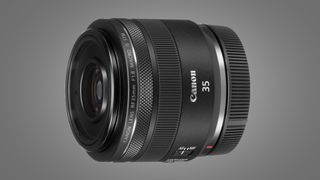
Wide-angle prime: Canon RF 35mm f/1.8 MACRO IS STM
Specifications
Reasons to buy
Reasons to avoid
At the time of writing, this is Canon’s only wide-angle prime lens in native RF mount, and it’s really not that ‘wide’ at 35mm. The upside is that it’s a particularly popular focal length that gives a very natural perspective, ideal for street, architectural and landscape photography, and much more besides.
Even more versatile than most 35mm primes, this one delivers 0.5x macro magnification at its shortest focus distance of 0.17m, so it can capture extreme close-ups. The only catch is that, as the distance is measured from the focal plane of the camera (effectively the active surface of its image sensor), and the lens’ inner barrel extends at shorter focus distances, the working distance between the front of the lens and the subject shrinks to just 6cm for 0.5x macro shooting.
Typical of non-L-series Canon lenses, there are no weather-seals and the hood is sold as an optional extra. Even so, build quality feels very good and there’s a separate customizable control ring, as well as onboard switches for AF/MF and on/off for the 5-stop image stabilizer.
As a fast yet compact and lightweight prime lens with great performance, it’s great value at the price. If you’re on an even tighter budget or want a more seriously ultra-wide-angle lens, try the fully manual Samyang MF 14mm F2.8 RF.
- Read our in-depth Canon RF 35mm f/1.8 IS Macro STM review

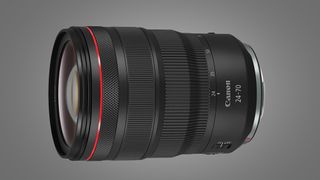
Standard zoom: Canon RF 24-70mm f/2.8L IS USM
Specifications
Reasons to buy
Reasons to avoid
Most of us shoot with a standard zoom lens, most of the time, so it pays to pick a good one. There are no less than four in the current Canon RF line-up. The RF 24-105mm f/4L IS USM, often sold as a kit lens with camera bodies, is a good option that combines a generous zoom range with a constant f/4 aperture rating. The newer RF 24-105mm f/4-7.1 IS STM is smaller, cheaper and more compact, while the RF 28-70mm f/2L USM has an uncommonly fast aperture but is big, heavy and very expensive, as well as being a little lacking in wide-angle coverage.
All things considered, the RF 24-70mm f/2.8L IS USM is the ideal ‘trinity’ standard zoom. It has a classic zoom range for a standard lens, combined with a fast and constant f/2.8 aperture rating, and delivers superb image quality and all-round performance.
L-series build quality includes weather-seals and fluorine coatings on the front and rear elements. There’s super-fast Nano USM autofocus, 5-stop image stabilization and top-quality glass including three aspherical elements, three UD elements and Air-Sphere Coating. It’s typically pricey but, for an RF mount standard zoom, it’s the pick of the crop.


Standard prime: Canon RF 50mm f/1.8 STM
Specifications
Reasons to buy
Reasons to avoid
Canon has majored on optical excellence in its line-up of RF lenses thus far, with few concessions to compactness and affordability. The result is that many RF lenses are big and heavy, especially in relation to slimline mirrorless EOS R-series bodies, and they’re also eye-wateringly expensive. That’s certainly the case with the range-topping RF 50mm f/1.2L USM, but the newer RF 50mm f/1.8 STM really bucks the trend.
It’s super-small at just 41mm in length, weighs a mere 160g and is by far the cheapest RF lens that Canon has made to date. Even so, it’s stylishly designed, impeccably finished and has a fast f/1.8 aperture rating. As you’d expect at the price, however, it doesn’t feature weather-seals and a hood isn’t included.
The lens feels right at home on smaller Canon mirrorless cameras like the Canon EOS RP. Handling benefits from a dual function control ring, which can be switched to manual focus or other duties like aperture control, ISO and exposure compensation. The optical path includes a precision-moulded aspherical element and Super Spectra coating.
Image quality is impressive with excellent sharpness and pleasantly smooth bokeh (the pictorial quality of defocused areas). You can’t go wrong at the price, but image stabilization would have been nice, especially when using the EOS R and RP, which lack in-body stabilization.


Portrait prime: Canon RF 85mm f/1.2L USM
Specifications
Reasons to buy
Reasons to avoid
For most of us, the moderately priced and easily manageable Canon RF 85mm f/2 Macro IS STM is an ideal lens for portraiture on any of Canon’s full-frame mirrorless EOS R series cameras. For those who demand an even tighter depth of field, as well as the ability to get faster shutter speeds under low lighting conditions without bumping up the camera’s ISO setting, the f/1.2L lens is simply the best.
Building on the legendary reputation of Canon’s EF 85mm f/1.2 lens for DSLRs, the RF mount edition is completely redesigned. It delivers superior sharpness which remains spectacular even when shooting wide-open, along with deliciously smooth bokeh. Raising the bar even higher, there’s also a pricier ‘DS’ version of the lens that features an additional ‘Defocus Smoothing’ coating, for softening the edges of bokeh discs caused by defocused lights.
Autofocus is much faster than in the older EF lens, while the high-tech optical path includes Air-Sphere Coating for minimizing ghosting and flare, and Blue Spectrum Refractive Optics that reduce color fringing to negligible levels. The L-series build includes weather-seals and, as with other high-end RF lenses, there’s a dedicated customizable control ring. If you want something cheaper with faster aperture and you don’t mind focusing manually, try the Samyang MF 85mm f/1.4 RF.
- Read our in-depth Canon RF 85mm f/1.2L USM review

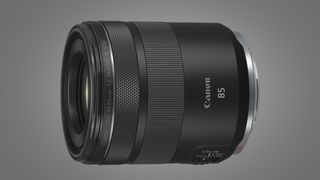
Macro lens: Canon RF 85mm f/2 Macro IS STM
Specifications
Reasons to buy
Reasons to avoid
As yet, Canon doesn’t make a full 1.0x or 1:1 macro RF mount lens, able to reproduce small objects at full life-size on the camera’s image sensor. The closest you can get is 0.5x or 1:2 magnification, as delivered by the RF 35mm f/1.8 and this RF 85mm f/2 lens. The longer focal length of this 85mm lens makes it more suitable for extreme close-ups, as the working distance between the front of the lens and the subject isn’t so tight. The lens also features a macro-friendly 3-position autofocus range limiter switch, absent on the RF 35mm lens.
Not just for close-ups, the focal length and fairly fast aperture rating of this lens also makes it ideal for portraiture and still life photography, while the fast autofocus system also makes it useful for shooting action sports and wildlife.
Getting back to macro shooting, one thing the lens shares in common with the RF 35mm is a hybrid image stabilizer which counteracts x-y shift as well as the more usual angular vibration or wobble. This makes stabilization much more effective when shooting extreme close-ups, enabling consistently sharp macro images in handheld shooting. If you’d rather have supersized 2x or 2:1 magnification from a macro lens, try the fully manual Laowa 100mm f/2.8 2:1 Ultra Macro APO.


Superzoom: Canon RF 24-240mm f/4-6.3 IS USM
Specifications
Reasons to buy
Reasons to avoid
Superzoom lenses are notorious for bumping up the zoom range while compromising image quality, typically with a drop in sharpness and a rise in distortions. The upside is that you can cover everything from wide-angle to telephoto shooting at the twist of a zoom ring, rather than having to change the lens on your camera, or carry additional lenses in your camera bag. As such, this type of lens is great for travel and walkabout photography.
Rising well above the norm, the RF 24-240mm delivers very good sharpness and, while distortions are very extreme, they’re automatically corrected in-camera, basically becoming a non-issue. Handling is natural and, as with some other RF lenses, a switch is featured that enables you to swap the action of the manual focus ring to other, customizable functions. There are no weather-seals and you need to buy the lens hood separately but, all in all, this is a lens that really puts the ‘super’ into superzoom.
- Read our in-depth Canon RF 24-240mm F4-6.3 IS USM review


Telephoto zoom: Canon RF 70-200mm f/2.8L IS USM
Specifications
Reasons to buy
Reasons to avoid
Think constant-aperture 70-200mm telephoto zoom and you’re probably thinking of a lens that has a fixed physical length which, like the aperture, remains constant throughout the zoom range. This one bucks the trend, with a telescoping design that enables a comparatively compact and lightweight construction. Even so, it has rock-solid build quality and features a full set of weather-seals, as you’d expect from an L-series RF lens.
The longest of the ‘trinity’ f/2.8 zooms, this lens is ideally suited to action sports and wildlife photography, as well as for shooting events and even portraiture. Image quality is excellent in all respects and real-world performance is boosted by a super-fast Dual Nano USM autofocus system, along with 5-stop image stabilization.
The stabilizer has three switchable modes, for static and panning shots, as well as a third mode that only applies stabilization during actual exposures. This makes it easier to track erratically moving objects in the viewfinder. As you’d expect from a flagship RF zoom, there’s a third control ring, as well as the usual zoom and focus rings, which can be customized for carrying out different functions.


Super-telephoto zoom: Canon RF 100-500mm f/4.5-7.1L IS USM
Specifications
Reasons to buy
Reasons to avoid
Picking up the baton from Canon’s highly popular EF 100-400mm zoom for DSLRs, this new lens for mirrorless EOS R-series cameras delivers even greater telephoto reach, but remains reasonably compact and lightweight for such a ‘super-telephoto’ lens. The trade-off is that the aperture shrinks to f/7.1 at the long end of the zoom range, so you might need to bump up your camera’s ISO setting if you need to freeze action under dull lighting conditions, which can degrade image quality.
Like the RF 70-200mm f/2.8, this lens features a triple-mode, 5-stop image stabilizer and a fast Dual Nano USM autofocus system. However, we found that autofocus speeds were a little pedestrian on EOS R and RP bodies. The lens really comes into its own on EOS R5 and R6 bodies, where it takes full advantage of the advanced, intelligent autofocus tracking for people, animals and birds.
It’s able to track them as they move around the frame with excellent accuracy and consistency. Unlike the 70-200mm f/2.8, the 100-500mm is compatible with Canon’s 1.4x and 2x RF ‘Extenders’ (tele-converters), but the aperture rating drops by a further one or two f/stops respectively.
- Read our in-depth Canon RF 100-500mm f/4.5-7.1L IS USM review

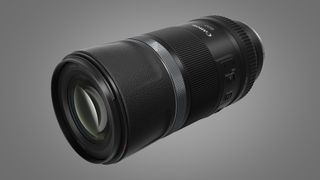
Super-telephoto prime: Canon RF 600mm f/11 IS STM
Specifications
Reasons to buy
Reasons to avoid
On paper, this lens looks a bit bonkers by modern standards. It has a fixed f/11 aperture that’s pretty ‘slow’ and can’t be altered. The upside is that the absence of a diaphragm mechanism is one of the factors that, along with a clever retractable design and the use of diffractive optics, makes this lens amazingly compact and lightweight for a 600mm super-telephoto prime.
Tipping the scales at just 930g, and with the addition of a 5-stop image stabilizer, it works brilliantly well for handheld photography, especially if you don’t mind increasing your camera’s ISO setting to freeze action under dull lighting conditions.
There are no weather-seals and the hood is sold as an optional extra but, even so, you get massive telephoto reach for the money, making the lens very good value. And if you feel that 600mm still isn’t long enough, an upsized RF 800mm f/11 IS STM lens is also available, and both are compatible with Canon’s RF 1.4x and 2x Extenders.

What to look for when buying a lens
Choosing the right lens for you camera is a complicated thought process. There are several factors to consider before making your decision, beginning with price. Affordability matters but if you did have the budget for good glass, then here are the the other considerations to keep in mind.
Purpose: To start with, think about what you want to use the lens for. If you're after all all-purpose, general-use lens, then a standard zoom lens like a 24-70mm might fit the bill perfectly, giving you various focal lengths as well as variable aperture. Standard zooms suits a variety of purposes, but if you shoot more macros, then a dedicated macro lens might be the best option. Or a wide-angle if you want to shoot a lot of landscapes, or primes for portraits.
Sensor format and lens mount: It's important to know what sensor your camera sports before you pick your first lens. Lenses are built specifically for 35mm (full-frame), APS-C, micro fourth thirds, and medium format bodies, although some can be used across some sensor sizes via an adapter. It also means you'll need to pick lenses that are compatible with your camera's lens mount, although you can use lens adapters while switching from a DSLR to a mirrorless body within the same brand (eg: Canon's EF lenses can be used on RF mounts).
Aperture: This is an important consideration as it controls how much light can enter a lens – the larger the aperture, the more light is going to hit the sensor, and vice versa. The f stop number in the name of the lens gives you the aperture, and the smaller the f stop number, bigger the aperture. For example, the RF 35mm f/1.8 Macro IS STM has a large aperture, meaning its low-light performance will be better than a lens with aperture of, say, f/5.6. The aperture also influences depth of field, aka that blurry background you see in some images. Large apertures like f/1.8 produce tighter depth of field, and thus very soft, blurry backgrounds and bokehs.
Image stabilization: Having a stabilized lens can be handy for handheld shoots, particularly when combined with a camera's in-body image stabilization (IBIS). This will increase the number of sharp images you capture by automatically correcting for hand and camera shake... to certain degree. Stabilized lenses from Canon are marked with 'IS' in the name.
Get daily insight, inspiration and deals in your inbox
Get the hottest deals available in your inbox plus news, reviews, opinion, analysis and more from the TechRadar team.
